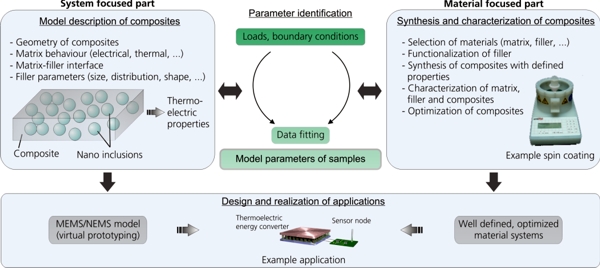Second project period 10/2010 - 03/2015
| Project No. | Project Name | Responsible |
|---|---|---|
| G2 | Modeling and synthesis of new nano material systems for NEMS focusing on thermoelectric composites |
Prof. Dr. Thomas OTTO Dr. Detlef BILLEP |
Main Objectives
- Synthesis and characterization of thermoelectric nano composites
- Development of multiscale models of thermoelectric composites
- Parameter identification methods using measurement results and analytical models
Description
Microelectromechanical systems (MEMS) and the counterpart in nanotechnology (NEMS) are systems of sensors and actuators integrated with digital and analog circuits or as multichip. With the raising field of nanotechnology new materials and transducer effects which are caused by the miniaturization could be used for new sensor and actuator principles. MEMS/NEMS already exist in form of complex structures which need simulation to predict their behavior. Therefore new materials have to be investigated with regard to theoretical aspects, as well as application and simulation [G2-1].
In this work we will concentrate on the behavior of nano inclusions embedded in a matrix to achieve an understanding of the physics of the thermoelectric effect. The range of dimensions contains elements from the macroscopic world as well as elements beyond the microscopic world. Located between those worlds these systems are so called mesoscopic. They build the bridge from classic physics to quantum physics hence special properties arise. There are two basic approaches for describing phenomena in this scale. On the one hand the top-down approach based on classic physics and on the other hand the bottom-up approach based on quantum physics. The usage of the approaches depends on several factors, for example on the size of the system. So-called multiscale approaches [G2-2] are used for simulation including several scales.
In general a composite consists of at least two different materials – the matrix and the filler i. e. nano particles. Because of the physical coupling the composite shows a different behavior than bulk material. Reducing at least one dimension to the nanometer scale dramatically alters charge transport properties due to confinement in the nanostructure [G2-3]. Its properties are influenced by micro-structural parameters such as volume fraction, filler shape and size distributions, as well as properties of matrix, filler and the interface between both.
As shown in Figure 1 this subproject consists of a system focused part and a material focused part. In the system focused part a model description of the composite is necessary for simulation of MEMS/NEMS. It will make the design of applications possible, where the material system can be used without having deeper knowledge about the composite itself. In the material focused part thermoelectric nano composites will be synthesized, characterized and optimized.

|
|
Fig. 1: Components of the project |
Parameter identification methods will be developed to connect the analytical model with the experimental one for verification. Furthermore the parameter identification will be used for the in-situ, indirect and non-destructive identification of model and material parameters. By performing a behavioral analysis with the analytical model for different parameters a response surface is generated. The theoretical data merged with the experimental data from the material focused part, for example by least square fit, yield to the searched parameters.
Additionally to the analytical and experimental optimization of the thermoelectric composites several applications will be proposed.
Cooperation is intended with the subprojects G5 (Lang), G6 (Albrecht), G7 (Zahn) and G8 (Hietschold).
References
| [G2-1] | ITRS Roadmap, Sematech & SIA, 2007 and 2008 update. |
| [G2-2] | Lu, Gang and Kaxiras, Efthimios: Overview of Multiscale Simulations of Materials.(2005) Handbook of Theoretical and Computational Nanotechnology, Vol. 10 |
| [G2-3] | Venkatasubramanian, R. et al.: Thin-film thermoelectric devices with high room-temperature figures of merit.(2001) Nature, Vol. 413, pp. 597-602 |




